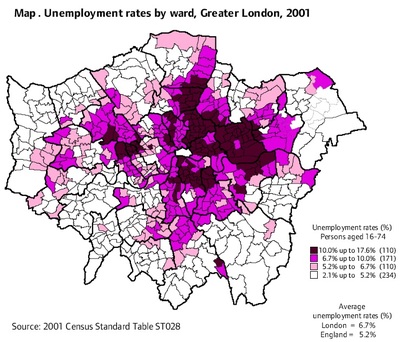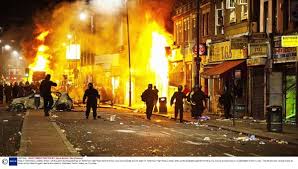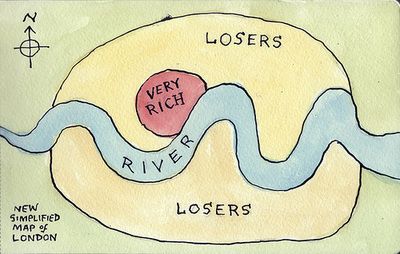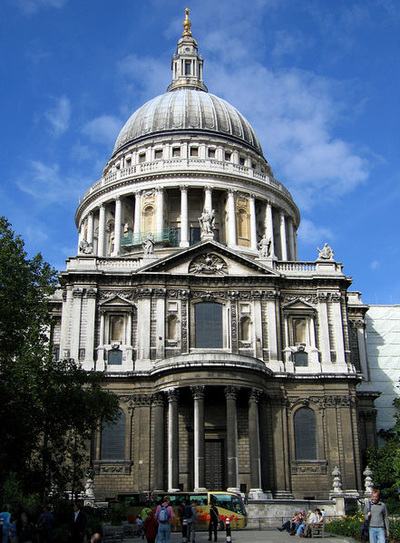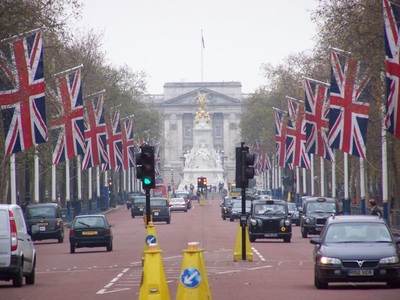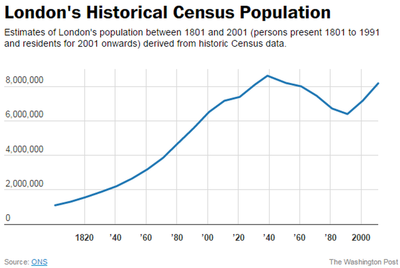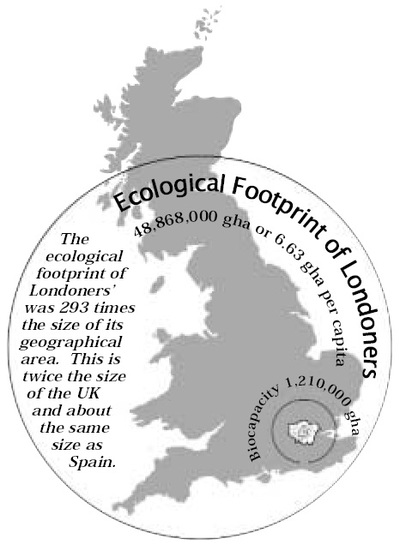London
|
London has been a major world hub for over three thousand years and is now one of the world two dominant World Cities. Throughout history its roles, functions and power have changed considerably and it has undergone significant remodeling on several occasions. With each of these periods of change urban dynamic have reshaped the city. Today, urban dynamics continue to reshape the city landscape based on economic, social and environmental pressures.
London is located in the South East corner of the United Kingdom and positioned on the Thames river. The CBD of London is the borough of Westminster (frequently called "the city" or "The Square Mile"). The administration of London is two tiered—a city-wide, strategic tier and a local tier. City-wide administration is coordinated by the Greater London Authority (GLA), while local administration is carried out by 33 borough governments. The GLAs is coordinated by the London mayor whose statutory planning strategy is published as the "London Plan", which was most recently revised in 2011. The local authorities are responsible for most local services, such as local planning, schools, social services, local roads and refuse collection. However, certain functions, such as waste management, are provided through joint arrangements. |
|
Social structure and spatial patterns of advantage and disadvantage, wealth and poverty, ethnicity
Pattern of Social Structure
Social structure refers to the form or pattern of the interrelationship of the people in society. In every society there is some form of social structure. This social structure both reflects and results in patterns of advantage and disadvantage which can be easily mapped.
Advantage in life’s opportunities, and usually social position, is subject to different criteria, ranging from the income and wealth of households to the extent of personal freedom. Social structure is influenced a variety of factors and patterns of advantage and disadvantage can be seen spatially by:
London’s social structure has been shaped by its long history and rigid class system, economic restructuring and social polarisation that is often present in large cities. There are clear geographical distinctions in London that have developed as a result of long term and short term urban dynamics.
Social structure refers to the form or pattern of the interrelationship of the people in society. In every society there is some form of social structure. This social structure both reflects and results in patterns of advantage and disadvantage which can be easily mapped.
Advantage in life’s opportunities, and usually social position, is subject to different criteria, ranging from the income and wealth of households to the extent of personal freedom. Social structure is influenced a variety of factors and patterns of advantage and disadvantage can be seen spatially by:
- Income and poverty
- Ethnicity
- Education levels, and
- Employment
London’s social structure has been shaped by its long history and rigid class system, economic restructuring and social polarisation that is often present in large cities. There are clear geographical distinctions in London that have developed as a result of long term and short term urban dynamics.
Income Patterns
Income is the amount of funds, goods or services received by an individual. London, like most world cities has seen a gradual rise in inequality as extremely high income jobs drive up real estate prices and costs of living.
Areas of income coincide closely with the broad pattern of wealth. There is a strong relationship between income and the wealth of an individual. Wealth consists of physical assets such as buildings, property and financial assets.
Areas of wealth have been favoured by market forces in London for over 500 years. Most recently, Suburbanisation drew high to middle income earners to the outer boroughs and left concentrations of low income in the inner eastern boroughs. Areas of high income such as Portobello or Chelsea are desirable creating market forces which exclude those who cannot afford property. Conversely, low income earners will readily flee disadvantaged areas, such as Elephant and Castle unless they are unable.
Key Points:
Income is the amount of funds, goods or services received by an individual. London, like most world cities has seen a gradual rise in inequality as extremely high income jobs drive up real estate prices and costs of living.
Areas of income coincide closely with the broad pattern of wealth. There is a strong relationship between income and the wealth of an individual. Wealth consists of physical assets such as buildings, property and financial assets.
Areas of wealth have been favoured by market forces in London for over 500 years. Most recently, Suburbanisation drew high to middle income earners to the outer boroughs and left concentrations of low income in the inner eastern boroughs. Areas of high income such as Portobello or Chelsea are desirable creating market forces which exclude those who cannot afford property. Conversely, low income earners will readily flee disadvantaged areas, such as Elephant and Castle unless they are unable.
Key Points:
- Poverty in London is largely relative poverty, defined by the UK government as being below 60 per cent of median income.
- High levels of disadvantage in London coexist with some of the greatest concentrations of wealth in Britain.
- Inner London is by far the most deeply divided part of the country, with the highest proportions of both rich and poor people anywhere.
- Over a third of children in Greater London are living in households with incomes below the government’s poverty threshold.
- Income poverty affects one in four of London’s population.
- London now has one of the highest unemployment rates in England, reversing the position which obtained in the 1970s and 1980s when the unemployment rate in London tended to be among the lowest for any region.
- Homelessness is much higher in London than elsewhere in the UK.
- The ethnic dimension of poverty is far more pronounced in London than in other regions.
Patterns of poverty
The most striking aspect of poverty in London is the enormous differences in rates of poverty between Inner and Outer London. Inner London shows rates of poverty for children, working age adults and pensioners which are far higher than for any region of England. Outer London shows rates of poverty which, while higher than in the neighbouring Eastern and South East regions, are nonetheless close to or below the national average.
High rates of disadvantage on a number of indicators characterise the great majority of adjacent electoral wards in an area stretching across most of North East London. Much of the Eastern boroughs around the Docklands area and Inner boroughs south of the Thames have traditionally been considered poorer, however, Urban renewal projects such as the docklands development and the 2012 Olympic village have stimulated urban renewal.
Disadvantage is a generalised characteristic of this area rather than a problem confined to a number of discrete ‘problem areas’. However, London has experienced a number of riots, most notably in 2011. These riots have been linked to the frustrations of generational disadvantage.
Among the factors which are important in explaining the pattern of disadvantage in London are:
inflation between 1991 and 2001, while male non-manual earnings increased by 26 per cent. With earnings rising for much of the workforce and a limited supply of housing in London, the cost of living in the capital has increased for all. For those in lower paid employment, particularly those with dependants, wages are increasingly failing to meet the cost of living.
The most striking aspect of poverty in London is the enormous differences in rates of poverty between Inner and Outer London. Inner London shows rates of poverty for children, working age adults and pensioners which are far higher than for any region of England. Outer London shows rates of poverty which, while higher than in the neighbouring Eastern and South East regions, are nonetheless close to or below the national average.
High rates of disadvantage on a number of indicators characterise the great majority of adjacent electoral wards in an area stretching across most of North East London. Much of the Eastern boroughs around the Docklands area and Inner boroughs south of the Thames have traditionally been considered poorer, however, Urban renewal projects such as the docklands development and the 2012 Olympic village have stimulated urban renewal.
Disadvantage is a generalised characteristic of this area rather than a problem confined to a number of discrete ‘problem areas’. However, London has experienced a number of riots, most notably in 2011. These riots have been linked to the frustrations of generational disadvantage.
Among the factors which are important in explaining the pattern of disadvantage in London are:
- The cost of housing, transport and childcare:
- The pattern of demand for labour: London’s labour market has changed dramatically over the last twenty years,
- The openness of London’s economy:
- The distribution of earnings:
inflation between 1991 and 2001, while male non-manual earnings increased by 26 per cent. With earnings rising for much of the workforce and a limited supply of housing in London, the cost of living in the capital has increased for all. For those in lower paid employment, particularly those with dependants, wages are increasingly failing to meet the cost of living.
Ethnicity
The existence of residential concentrations of ethnic groups seems to be an integral part of the process of new immigrant populations entering alien territories. London, New York, Paris and Sydney are typical of large cities with enclaves of migrants.
Different races have mixed in London for centuries as it was a city of trade. But as London became the heart of a global empire, people from all over that empire began to live in London for trade, education and cultural reasons.
Following the decolonisation of the Empire large numbers of immigrants have come to London from the former colonies in waves. Southern Asian groups (Indians Pakistani and Bangladeshis) came in 1960-70s, Africans and Carribbeans came in the 70s and 80s and Chinese groups came in the 1990s and 2000s as Hong Kong returned to Chinese control. More recently, London has accommodated many migrants from Eastern Europe who have recently joined the European Union Schengen Zone.
Like any city with large numbers of immigrants, social tensions regarding migration and immigrants are found in London.
The existence of residential concentrations of ethnic groups seems to be an integral part of the process of new immigrant populations entering alien territories. London, New York, Paris and Sydney are typical of large cities with enclaves of migrants.
Different races have mixed in London for centuries as it was a city of trade. But as London became the heart of a global empire, people from all over that empire began to live in London for trade, education and cultural reasons.
Following the decolonisation of the Empire large numbers of immigrants have come to London from the former colonies in waves. Southern Asian groups (Indians Pakistani and Bangladeshis) came in 1960-70s, Africans and Carribbeans came in the 70s and 80s and Chinese groups came in the 1990s and 2000s as Hong Kong returned to Chinese control. More recently, London has accommodated many migrants from Eastern Europe who have recently joined the European Union Schengen Zone.
Like any city with large numbers of immigrants, social tensions regarding migration and immigrants are found in London.
- London has the lowest proportion of people born in the UK (72.9 per cent)
- London has the highest proportion of people from minority ethnic groups apart from more who identified themselves as of Pakistani origin, of whom there is a higher proportion in Yorkshire and the Humber (2.9 per cent) and the West Midlands (2.9 per cent).
- In 2001 six out of ten Londoners were White British (nearly 4.3 million people) and four out of ten were from ethnic minority groups (nearly 2.9 million people).
- There were slightly more people who were Asian or Asian British (12 per cent of London’s population) than Black or Black British (11 per cent of London’s population).
- The largest ethnic minority group in London was the Other White group. (These were White people who were not White British or White Irish, and therefore the group includes many other European people). Following the Other White group in size were the Indian, Black African, Black Caribbean and White Irish groups. The Bangladeshi, Pakistani and Other Asian ethnic groups were next.
- Seven of the London boroughs with the highest proportions of ethnic minorities were in Inner London and three in Outer London, whereas nine of the ten boroughs with the lowest proportions of ethnic minorities were in Outer London.
- The borough with the largest proportion of ethnic minorities was Brent where 71 per cent of the population were from ethnic minority groups (including White minorities), followed by Newham, Tower Hamlets, Hackney and Ealing.
- There were nine boroughs in London which had ethnic minority populations which were more than half the borough’s population.
Employment
The key points are:
The key points are:
- In April 2001, the unemployment rate in Greater London was 6.7 per cent – one of the highest rates across England and Wales, second only to that of the North East.
- London’s regional position is largely driven by high unemployment levels across Inner London boroughs where unemployment rates average 8.9 per cent. Across Outer London, unemployment levels (5.4 per cent) are nearer the national average (5.2 per cent).
- Across London, borough rates vary from 3.6 per cent in Sutton up to 12.3 per cent in Newham. Rates are also very high in Hackney and Tower Hamlets (both 11.8 per cent).
- While Outer London has low unemployment relative to Inner London, it still has pockets of high unemployment – four per cent of wards in Outer London had rates of 10 per cent and over. 45 per cent of Outer London wards had rates above the national average.
- Unemployment rates are high for young Londoners. Rates among 16-24 year olds are 12.3 per cent – twice as high as rates for those aged 25 and over. Unemployment levels are higher still for those aged 16-19 (22.3 per cent).
- Unemployment rates for BME (Black and minority ethnic groups) groups across Greater London average 11.3 per cent – more than twice as high as rates for White groups (5.3 per cent). Unemployment levels are highest for Bangladeshi (20.5 per cent) and Black groups (who have an average rate of 14.3 per cent).
- Women have lower unemployment rates than men across most ethnic groups except for Pakistani women who had higher rates (13.3 per cent) than those of Pakistani men (11.6 per cent). Bangladeshi and Indian women also had rates very close to those of men.
- Those in poor health are more than twice as likely to be unemployed as those in good health (14.1 per cent compared with 5.7 per cent). Unemployment rates for those with poor health are highest in the boroughs of Tower Hamlets (23.3 per cent) and Hackney (21.8 per cent).
- People with no qualifications are almost three times more likely to be unemployed than those with higher level qualifications (11.1 per cent compared with 4.2 per cent). Rates for those with no qualifications are very high across Inner London (17.1 per cent).
- In terms of their former jobs, unemployed people tended to be over-represented in lower paid occupations and sectors (eg hotels and catering sector, sales and customer service occupations), compared with workers generally.
Further Reading - Social Structure:
Codrington, S. (2016) Planet Geography, London's Social Structure, p.570
Codrington, S. (2016) Planet Geography, London's Social Structure, p.570
Changing economic character, nature and location of residential land, commercial and industrial development
Changing economic character
London experienced a decline in population (counter urbanisation) across much of the 20th Century. However, its population has recently surpassed its Pre-war population.
London experienced a decline in population (counter urbanisation) across much of the 20th Century. However, its population has recently surpassed its Pre-war population.
- London was a major city prior to the industrial revolution
- Early function as a seaport and commercial centre formed a building block for current financial developments
- Trade generated population growth and profits but also the need for financial service industries, such as insurance and accounting.
- The deregulation of the UK finnance sector is refered to as "the big bang" which allowed massive growth.
- Today London continues to be important as one of the three top world cities, exerting economic authority and control
- Since the 1960-70s manufacturing as been in decline in London. However, highly skilled manufacturing remains in demand.
- The service sector now dominates London’s economy. Over a third of jobs in London are in the business and finance industry. Other key services are, public sector, law, marketing and advertising, tourism and hospitality, creative and cultural industries.
- Manufacturing does still continue in the London economy
Decentralisation has created many town centres across London.
|
Nature and location of commercial and industrial development
Commercial activity has historically been focused on The square mile. However, this has now expanded to include the docklands secondary CBD. The Greater London Authority aims to fund many commercial town centres across London to promote a more decentralised city. Urban blight and decay created by the de-industrialised of London since the 1950s has been addressed as former industrial land (brown fields sites) is renewed and residential and commercial land replaces the previous land use. |
Nature and location of Residential land
Residential land was divided into inner and outer boroughs and ringed by the "green belt". Outer boroughs were wealthier. Today inner boroughs have begun acquire greater value due to changes in lifestyles and culture. Even those in the East end which were historically quite working class have gentrified. After World War 2, large amounts of public housing was rapidly constructed to accomodate people and encourage home ownership. However, "council estates" have long been associated with significant disadvantage and plans are in place for their removal. Critics point out that London has a severe housing shortage. The use of former brownfields sites is a significant opportunity, but is unlikely to accomodate all the required growth. There are residential development corridors planned along the Thames gateway and Standsted corridor. |
Further Reading - changing economic character, residential and commercial land:
City of London (2016) The London Plan, available at: https://www.london.gov.uk/
Kleeman (2009) London as a World City
City of London (2016) The London Plan, available at: https://www.london.gov.uk/
Kleeman (2009) London as a World City
Culture of place
Architecture
The architecture includes over 3000 years of urban settlement and displays the various periods of history that London has progressed through.
The architecture includes over 3000 years of urban settlement and displays the various periods of history that London has progressed through.
Street scape
London is a city packed with elegant squares and green expanses. Narrow streets and distinct footpaths will identify London in any photograph as will the London underground signs. High Street shopping and unique Pubs are also frequently seen across London. Remnants of London’s downturn in the 80s and social housing projects mean that there are pockets of crumbling infrastructure in places.
London is a city packed with elegant squares and green expanses. Narrow streets and distinct footpaths will identify London in any photograph as will the London underground signs. High Street shopping and unique Pubs are also frequently seen across London. Remnants of London’s downturn in the 80s and social housing projects mean that there are pockets of crumbling infrastructure in places.
Noise and colour
London’s culture and way of life has also given rise to a unique brand of noise and colour. This includes:
London’s culture and way of life has also given rise to a unique brand of noise and colour. This includes:
- Accents from around the world, and in particular the Cockney (east end) accent. (Multi coloured… no longer a white persons city)
- Frequent overcast weather and atmospheric dust (grey)
- Diesel engines (red buses and black cabs)
- Speaker’s corner in Hyde Park (expansive green spaces)
- Brit pop, club scene and Punk movements
- London is a quite patriotic city with the Union Jack (the combined flags of England, Scotland and Wales) frequently displayed (red white and blue)
Lifestyle
No such thing as a typical Londoner or a typical lifestyle in London.
But… for many (yes, a stereotype):
No such thing as a typical Londoner or a typical lifestyle in London.
But… for many (yes, a stereotype):
- Monday to Friday is about work, while Friday and Saturday are about going out. Sundays include football, newspaper and roast lunch.
- 11 o’clock closing of pubs gives rise to binge drinking culture and late dinners at “curry restaurants”.
- London is an exhilarating, busy and fast paced city, but also a very expensive one.
- To buy an average home in London requires an average salary of £55,000 (AUS$136,800), however in reality the average salary is only £34,777 (AUS$86,500).
- Key workers are particularly hit as the average school teacher in London earns £26,360, a staff nurse makes £21,950 and a postal worker earns only £21,180. (note: in mid 2006, 1 UK£ = AUS$ 2.49).
- The overall average rent for two-bedroom accommodation for all boroughs is £214. The corresponding average rent for all central boroughs is £321, and for other boroughs £201.
- Only those earning over £60,000 would be considered affluent.
- Most Londoners have a strong pub culture and spend considerable time at the local pub or bar.
Vitality
London has a creative energy that comes from being a very large and dominant global city with many diverse lifestyles and cultures. This has, and continues to give rise to many waves of global culture.
London has a creative energy that comes from being a very large and dominant global city with many diverse lifestyles and cultures. This has, and continues to give rise to many waves of global culture.
- The pull of people towards London means it contains much creative energy.
- London’s constant state of flux makes it a very vibrant and vigorous place in which to live and visit.
Further Reading - Culture of Place
de Botton, J. (2013) Culture of place, Geography Bulletin, Vol 35, No. 1
Kleeman, G. (2009) Culture of Place, Global Interactions
de Botton, J. (2013) Culture of place, Geography Bulletin, Vol 35, No. 1
Kleeman, G. (2009) Culture of Place, Global Interactions
Growth, development, future trends and ecological sustainability
Growth
Over the next 15 years, London faces a major increase in population. It is still anticipated that London will have 700,000 more people by 2016 than it has now. It important to plan for the need for more jobs, and for a suitable range of jobs for what will be an increasingly diverse workforce.Growing demand for services: the 2000/01 Family Expenditure Survey showed that for the first time, typical London households spend more on leisure goods and services than on food
Future Trends
Failure to look at what is happening to London’s job market and identify ways to ensure it works effectively in the future, will reinforce historical patterns of disadvantage and raise the spectre of new social problems, which will make living in London an increasingly unjust and unpleasant experience for everyone. The multiple levels of disadvantage and exclusion experienced by some communities has been linked to home grown terrorism and extremism. Riots are another outcome that could increase with inequality.
London’s competitive advantage for services can be shown by looking at London’s share of the UK’s total service sector employment. London has particular advantages in a wide range of high-value, high-skill and knowledge-intensive activities (ranging from broking to the music business). Some are closely linked to other sectors, such as air transport, tourism, fashion design and other cultural activities. These services, and those needed to support them, are increasingly locating in London. This is impacting on the structure of all parts of the city. The 52% national support from a Brexit vote in June 2016 could be potentially devastating for London's globalised economy.
It is likely that the bulk of mainstream financial and business services will remain clustered in this central district. Leading financial organisations elect to locate close to their competitors and peers, with specialist support services, such as legal, accountancy and management consultancy, growing up around these clusters. However, the UK will likely promote the importance of regional centers as employment hubs in order to use decentralisation and counter urbanisation to ease London's transport and resource use. The Brexit vote also highlights that people are not comfortable with the increasing integration of the European Union.
There are key parts of London where manufacturing is still of key importance. In such places, it is worth taking steps to promote and encourage the types of high-value added manufacturing that are increasingly necessary for the sector’s survival (see the GLA report on cultural industries). The move towards more skilled jobs is another of the human pressures facing the London employment market. Skills shortages cause problems for employers, while lack of sometimes even basic skills can make it difficult for some Londoners to find work.
Over the next 15 years, London faces a major increase in population. It is still anticipated that London will have 700,000 more people by 2016 than it has now. It important to plan for the need for more jobs, and for a suitable range of jobs for what will be an increasingly diverse workforce.Growing demand for services: the 2000/01 Family Expenditure Survey showed that for the first time, typical London households spend more on leisure goods and services than on food
Future Trends
Failure to look at what is happening to London’s job market and identify ways to ensure it works effectively in the future, will reinforce historical patterns of disadvantage and raise the spectre of new social problems, which will make living in London an increasingly unjust and unpleasant experience for everyone. The multiple levels of disadvantage and exclusion experienced by some communities has been linked to home grown terrorism and extremism. Riots are another outcome that could increase with inequality.
London’s competitive advantage for services can be shown by looking at London’s share of the UK’s total service sector employment. London has particular advantages in a wide range of high-value, high-skill and knowledge-intensive activities (ranging from broking to the music business). Some are closely linked to other sectors, such as air transport, tourism, fashion design and other cultural activities. These services, and those needed to support them, are increasingly locating in London. This is impacting on the structure of all parts of the city. The 52% national support from a Brexit vote in June 2016 could be potentially devastating for London's globalised economy.
It is likely that the bulk of mainstream financial and business services will remain clustered in this central district. Leading financial organisations elect to locate close to their competitors and peers, with specialist support services, such as legal, accountancy and management consultancy, growing up around these clusters. However, the UK will likely promote the importance of regional centers as employment hubs in order to use decentralisation and counter urbanisation to ease London's transport and resource use. The Brexit vote also highlights that people are not comfortable with the increasing integration of the European Union.
There are key parts of London where manufacturing is still of key importance. In such places, it is worth taking steps to promote and encourage the types of high-value added manufacturing that are increasingly necessary for the sector’s survival (see the GLA report on cultural industries). The move towards more skilled jobs is another of the human pressures facing the London employment market. Skills shortages cause problems for employers, while lack of sometimes even basic skills can make it difficult for some Londoners to find work.
Ecological Sustainability
Ecological sustainability is a major concern globally and as more people move into metropolitan areas cities are becoming focal points for ecological sustainable development. The development of a large urban area such London has major impacts on its environment, including the ecology of its environment. Such a large urban area:
Together these impacts make up the ecological footprint of a city. The footprint provides an estimate of the total area of productive land and water required on a continual basis to produce all of the resources consumed, and assimilate all the waste produced by a population.
Large cities, such as London, have a wide range of inputs necessary to provide liveability, including land, water, food, energy, building materials and waste outputs. The ecological sustainable development of London depends on effectively reducing resource inputs and waste outputs, while at the same time maintaining the liveability of urban areas.
Governments can contribute to ecological sustainability through legislation that acts in two main ways:
London needs to address sustainability from both a global and local perspective. There is also the need to address a triple bottom line that incorporates environmental, but also social and economic costs of development.
Lastly, Global warming will have significant impacts on London. The Thames is already a concern for London due to a geological sinking of the city. When combined with increased flooding events this poses a serious challenge.
London will also have to accomodate a change in climate that may result in drier conditions with more summer heat waves. These changes may result in London experiencing water scarcity. "Urban greening" is seen as a way of addressing both the urban heat island effect and the loss of permeability that cities face. There is a movement to create a London-wide National park to link green spaces.
Ecological sustainability is a major concern globally and as more people move into metropolitan areas cities are becoming focal points for ecological sustainable development. The development of a large urban area such London has major impacts on its environment, including the ecology of its environment. Such a large urban area:
- Has a huge demand for natural resources
- Obliterates the natural hydrological system within its area
- Produces waste products, including solid and liquid waste, air pollutants, heat and noise, which alters the environment around it
- Reduces biomass and alters the species of plants and animals in and around it
- Creates new land through reclamation and landfill
Together these impacts make up the ecological footprint of a city. The footprint provides an estimate of the total area of productive land and water required on a continual basis to produce all of the resources consumed, and assimilate all the waste produced by a population.
Large cities, such as London, have a wide range of inputs necessary to provide liveability, including land, water, food, energy, building materials and waste outputs. The ecological sustainable development of London depends on effectively reducing resource inputs and waste outputs, while at the same time maintaining the liveability of urban areas.
Governments can contribute to ecological sustainability through legislation that acts in two main ways:
- Encouraging households and industry to reduce the amount of resources they consume, such as encouraging energy efficient water heating, and increasing the price of water to discourage its wasteful use.
- Encouraging a reduction in the amount of waste created, such as reducing packaging, using more energy efficient equipment, re-using and recycling materials, educating citizens in more efficient ways of reducing resource use and waste production.
- London is also aiming to reduce transport pressures and hence fuel usage by promoting regional hubs of employment.
London needs to address sustainability from both a global and local perspective. There is also the need to address a triple bottom line that incorporates environmental, but also social and economic costs of development.
Lastly, Global warming will have significant impacts on London. The Thames is already a concern for London due to a geological sinking of the city. When combined with increased flooding events this poses a serious challenge.
London will also have to accomodate a change in climate that may result in drier conditions with more summer heat waves. These changes may result in London experiencing water scarcity. "Urban greening" is seen as a way of addressing both the urban heat island effect and the loss of permeability that cities face. There is a movement to create a London-wide National park to link green spaces.
